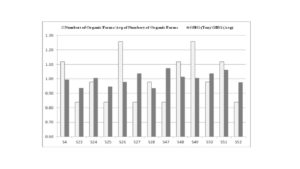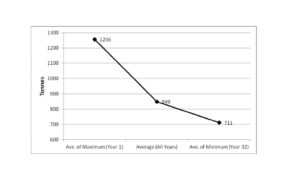The goal was to run the model with the simple scenarios, and evaluate the response of agents to various policies and instruments. The results indicate that combinations of support for conversion to organic farming are likely to stimulate the transition. In our models, 13 scenarios out of 52 had outcomes in which conversion occurred (Figure 7). Scenario 26 demonstrated the highest number of farm conversions to organic farming, with the minimum GHG emissions. This occurred when weighting system 6 was implemented.

Figure 7- The outcome of 13 scenarios using weighting system number six
This scenario produced levels of conversion within the range of those reported in the literature (for details, see MacRae et al., in review). The trend lines of GHG emission output for a period of 32 years was used to check feedback in the model. Figure 8 presents GHG production for scenario 26. The maximum amount of GHG produced by conventional farms is about 1256 Tonnes per year. The amount of GHG emission dropped about 43.4% at the end of period, to 711Tonnes after some conversions to organic farming. However, the GHG emissions of the other 12 scenarios, including the first scenario (a total of 14 scenarios) were also compared. The results show that the mean GHG production in a period of 32 years could be classified in three categories - lowest amount of GHG produced (<850 Tonnes), middle (850-860 Tonnes), and highest amount of GHG emitted (Over 860 Tonnes).

Figure 8 - GHG emissions in a period of 32 years for scenario 26
Concluding Remarks
In his paper, we presented an ABM approach to modeling complex agricultural systems at the watershed scale and parameterized the model using current literature. The operation of the model reflects phenomena reported in the literature and, thus, indicates that the internal logic and initial parameterization are reasonable. Running more complex scenarios requires further model calibration, sensitivity testing, and verification.
Acknowledgements:
This research was supported by a grant to the Organic Science Cluster project funded by Agriculture and Agri-food Canada. Special thanks to Phil Beard, General Manager of the Maitland Valley Conservation Authority, Dr. Stewart Sweeney, Environmental Management Specialist of the Ontario Ministry of Agriculture, Food and Rural Affairs, and Drs. Andy Hammermeister and Ralph Martin, then of the Organic Agriculture Centre of Canada who provided key data for the study.

